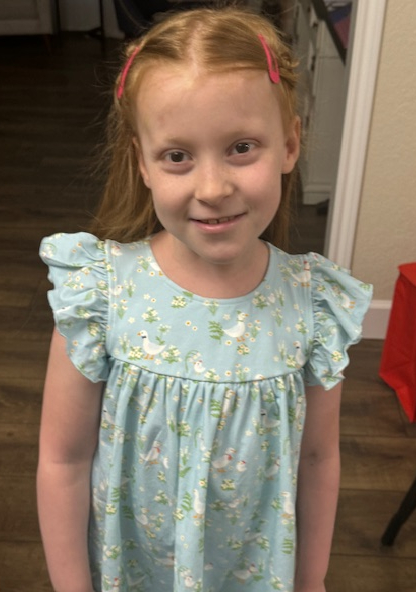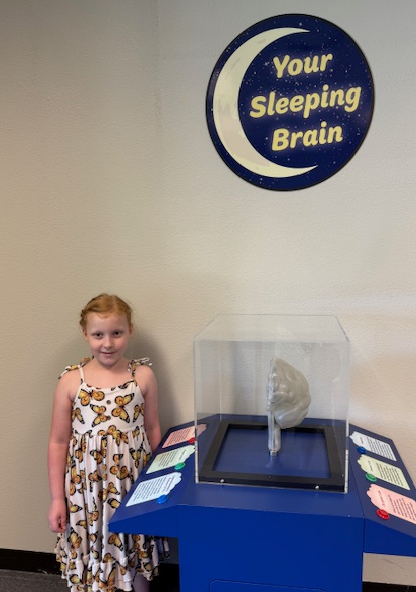Rosie's Story: Navigating Pediatric Epilepsy Treatment and the Rare Diagnosis of ESES
Rosie Tomes experienced her first seizure when she was seven years old just days before her family moved from Missouri to San Antonio.
What began as a frightening medical emergency would lead her parents, Shawna and Jonathan, to discover that Rosie has a rare and complex form of epilepsy that affects her ability to move, speak and learn.
Through advanced neurological care at CHRISTUS Children’s, careful medication management and ketogenic therapy through the hospital’s Keto for Kids clinic, Rosie’s care team helped stabilize her condition and restore most of her skills. Her journey is one of resilience, faith and perfect timing—every challenge and breakthrough seemed to align just when Rosie needed them most.
Meet Rosie's Pediatric Epilepsy Team
A Diagnosis of Epilepsy
On March 30, 2024, Rosie experienced her first major seizure.
She was in the car with us, buckled into her car seat, thankfully, when it happened,
Shawna recalled.
We were on the way to get more moving boxes from Lowe’s so we could keep packing. Her second seizure happened on the way home from the ER—again, in her car seat. We turned right around, and she was transferred from the Lebanon ER to Mercy Children’s Hospital in Springfield.
On Easter morning, doctors diagnosed Rosie with epilepsy, marking the beginning of a long and life-changing journey for her family. The hospital in Missouri referred them to CHRISTUS Children’s, where Rosie began seeing Dr. Fred Perkins, Jr., medical director of the hospital’s Epilepsy Center.
We got in to see him pretty quickly after we arrived,
Shawna said. "He walked us through what to expect with Rosie’s care.” Dr. Perkins ordered a new EEG and MRI to compare with prior hospital results. He explained that Rosie’s symptoms were consistent with benign rolandic epilepsy (BRE), a childhood form of epilepsy that often causes focal seizures during sleep.
Dr. Perkins kept Rosie on Keppra, the anti-seizure medication started in Missouri, but within weeks, her parents noticed troubling changes. “She became irritable and aggressive,” her parents said. “It wasn’t our Rosie. That’s when we realized the medication just wasn’t right for her.”
After consulting with Dr. Perkins, they switched to Lacosamide, which stabilized her for a while. “Once we got the dosage right, it worked,” Jonathan said. “But every time she got sick, we’d see breakthrough seizures.”
Fighting Lightning in the Brain
The Tomes family quickly learned that anti-seizure medications can be unpredictable. “It’s like fighting lightning in the brain,” Jonathan said. “The seizures find their way around the medication, especially when she’s sick. You have to stay one step ahead.”
By late 2024, Rosie’s care included regular follow-ups with Dr. Perkins and his team. When breakthrough seizures continued, he added Topiramate to help calm overactive nerve activity. For a time, it worked—but by early 2025, new and puzzling symptoms appeared.
A Turning Point in Rosie’s Diagnosis
By February 2025, Rosie’s parents began noticing changes that didn’t seem seizure related. “She would clench her hands all day,” said Shawna. “She was in pain, walking on her tiptoes, developing new behaviors that looked like autism.”
At school, teachers noticed differences, too. They suggested Rosie wear only tennis shoes because of possible sensory issues, but the changes didn’t make sense. “She was dropping things, falling, getting clumsier,” Shawna said. “She had already been tested for autism, and it was negative.”
By March, Rosie’s symptoms intensified. She began forgetting basic skills—how to write her name, feed herself, even get dressed. The day before a scheduled autism screening, she had her first daytime tonic-clonic seizure.
“She was sitting at the table eating breakfast,” Shawna recalled. “I ran upstairs for a moment, and when I came back down, she had fallen from her chair and was seizing. It was the first time it happened while she was awake. That’s when I knew something had changed.”
During the autism evaluation the next day at CHRISTUS Children’s, Rosie began having multiple seizures—drop spells, myoclonic jerks and staring episodes—right in the exam room.
The autism screener paused the session, and Dr. Melissa Svoboda, division chief of Neurology and Development, director of the Autism Program and part of the hospital’s multidisciplinary panel, immediately stepped in. After observing Rosie, she said, “We need to stop the test. I’ve seen at least three different seizure types in just 10 minutes.”
A Rare Diagnosis: Electrical Status Epilepticus in Sleep (ESES)
By what Shawna calls divine timing, every specialist Rosie needed happened to be in the building that day including Dr. Perkins and the EEG technician, who had one last opening.
“It was truly perfect timing,” said Shawna. “Within hours, Dr. Perkins confirmed what had been causing everything — the regression, the new seizure types, the loss of skills. It was something rare called
Electrical Status Epilepticus in Sleep, or ESES.”
ESES is a rare condition where the brain shows near-continuous seizure activity during sleep, often without visible seizures. This electrical disruption affects learning, memory and motor function and can cause developmental regression if untreated.
“With ESES, timing is everything,” said Dr. Perkins. “The longer the brain stays in that electrical state, the more developmental ground a child can lose. When caught early and treated properly, children have a much better chance of recovery.”
Dr. Perkins started Rosie on Depakote, and within weeks her brain activity began to stabilize.
“At first, the seizures got worse,” Jonathan said. “But once the medication built up in her system, everything calmed down. That medication truly made all the difference.”
A follow-up EEG later confirmed that Rosie was no longer in ESES. Even with that good news, the Tomes family wanted to do everything possible to support her recovery.
The Keto for Kids Program at CHRISTUS Children’s
After learning about the ketogenic diet’s success in epilepsy care, Shawna said, “We thought, we need to use every tool available to us. When we mentioned it to Dr. Perkins, he immediately connected us with the Keto for Kids Clinic at CHRISTUS Children’s.”
The program helps families implement ketogenic therapy, a high-fat, low-carbohydrate diet that changes how the brain uses energy and can reduce seizure activity, especially in children with conditions like ESES when medications alone aren’t enough.
“For certain patients, combining medication with ketogenic therapy can be beneficial,” said Dr. Perkins.
“The ketogenic diet isn’t a replacement for medication — it’s a complement to it. For patients like Rosie, that combo helps control seizures more effectively and gives them the best chance to regain lost skills.”
Under close supervision, the Tomes family began tracking Rosie’s ketone and glucose levels nightly to maintain ketosis. The clinic provided detailed guidance and support throughout the process, ensuring they felt confident managing the diet at home.
Over the next few months, Rosie’s seizures stayed under control. She gradually tapered off two of her three medications, staying only on Depakote with the ketogenic diet.
“She had a few breakthrough seizures early on, but she’s been seizure-free for two months now,” said Shawna. “It’s such a relief to see her doing so well.”
The Keto for Kids team also worked closely with the family to make the diet sustainable long-term. They provided meal plans, recipe handouts and tips for maintaining ketosis—whether at home or traveling.
“They talked about ways to make it fun and realistic,” Shawna said. “When we went to the beach this summer, I spoke to the restaurant staff, and they brought out a special keto-friendly mac and cheese for Rosie. She was so excited — she said it was the best day ever. It made her feel like every other kid.”
The clinic continues to help families track lab work to ensure children stay healthy while on the diet.
“You have to monitor everything — calcium, electrolytes, vitamins,” Jonathan explained. “The clinic keeps a close eye on all of that. They’ve been a huge part of keeping Rosie healthy.”
Rosie Today: Progress and Perseverance
Today, Rosie is a lively second grader with a bright smile and an even brighter spirit. She continues occupational and speech therapy and is regaining the skills she lost.
“She can dress herself again, write her name and read at a first-grade level,” Jonathan said. “Math has been slower, but she’s catching up.”
Shawna added, “She’s back to playing with her siblings, dancing and running outside. Her sense of humor is coming out again, and we’re seeing her full personality shine.”
The family stays in close contact with Dr. Perkins and the epilepsy team, who continue monitoring Rosie with EEGs every six months and adjusting treatment as needed. “Regression is always a risk,” said Shawna, “but we have an amazing team keeping us on track.”
When asked what has made the biggest difference, the Tomes family didn’t hesitate. “The care at CHRISTUS Children’s has been incredible from Dr. Perkins to the neurology team, the nurses, and everyone at the Keto Clinic,” they said. “They’ve gone above and beyond for our family.”
“Dr. Perkins is thorough and compassionate,” Jonathan said. “Because Rosie and her brother shared developmental delays, Dr. Perkins offered to check George’s heart during one of Rosie’s neurology appointments. He detected a heart murmur and quickly referred us to a cardiologist at CHRISTUS Children’s. It’s that kind of coordinated care that shows how truly invested they are in their patients.”
Through all the ups and downs, the Tomes family — now a family of five after welcoming a baby boy this fall — says their faith has carried them. “God knows best,” Shawna said softly. “Even when it’s hard, I’ve learned to give it all to Him. This journey has taught us to trust His timing completely.”
To learn more about the compassionate care and advanced treatments offered through the Epilepsy Center at CHRISTUS Children’s, visit Pediatric Neurology in San Antonio | CHRISTUS Children's Hospital


